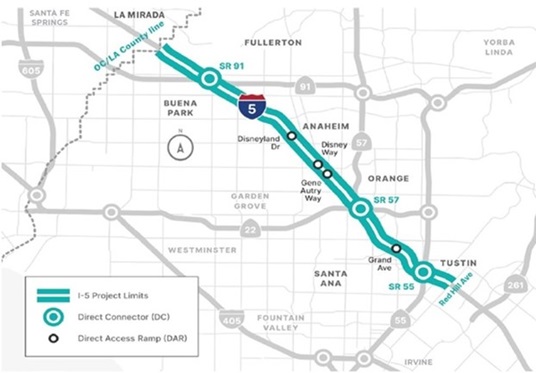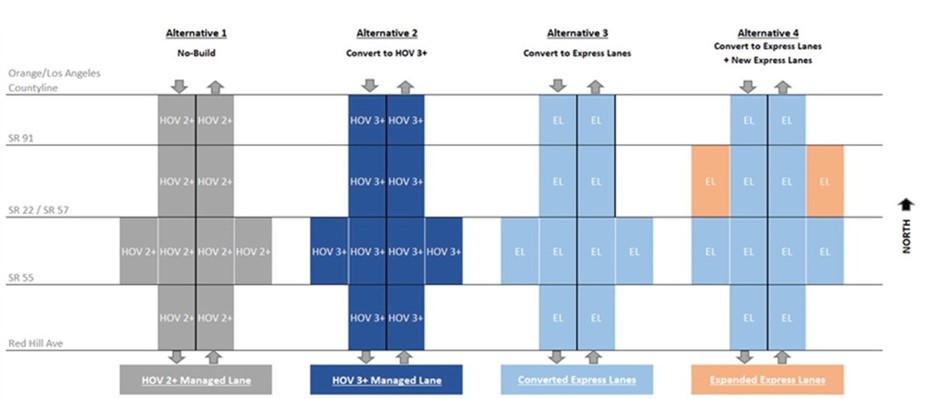I-5 Managed Lanes Project (Red Hill Ave. to OC/LA County Line)
The I-5 Managed Lanes Project includes a 15.5-mile section of Interstate 5 (I-5) between Red Hill Avenue, south of State Route 55 (SR-55), and the Orange/Los Angeles County Line that will address operational deficiencies related to High-Occupancy Vehicle (HOV) degradation through studies of alternatives that include priced managed lanes (also known as Express Lanes) strategies.
Currently, the Project’s corridor has three major freeway-to-freeway Direct Connectors at SR-55, SR-22/SR-57, and SR-91, four Direct Access Ramps at Grand Avenue, Gene Autry Way, Disney Way, and Disneyland Drive, and at least one HOV lane in each direction. The Project proposes intermediate ingress and egress access locations along the Express Lanes corridor. The purpose of this project is to improve the overall movement of people and goods along this section of I-5 through the cities of Irvine, Tustin, Santa Ana, Orange, Anaheim, Fullerton, Buena Park, La Mirada, and Santa Fe Springs.

Project Status: Environmental Phase
Caltrans is the lead agency under the National Environmental Policy Act (NEPA) and the California Environmental Quality Act (CEQA). Caltrans is preparing a Final Environmental Document (FED) pursuant to CEQA and NEPA guidelines. The Project is currently in the environmental phase. The Draft Environmental Document (DED) was completed in June 2023, and the FED is anticipated for approval in summer 2025. Read more about the environmental study process below.
Upcoming Public Hearing
Caltrans has submitted a Toll Facility Application to the California Transportation Commission (CTC) pursuant to Assembly Bill (AB) 194. Frazier. This application requests authority to build and operate toll lanes on I-5 in Orange County. As part of the AB 194 process, the CTC holds a public hearing near the project area to solicit feedback prior to making a decision on the Toll Facility Application. Members of the public may attend and provide comments both in person and virtually over Zoom; a date has not yet been set for this meeting. The CTC will not take action on the application at the public hearing. Upon approval of an application, Caltrans may develop and operate the proposed toll facility, subject to the minimum requirements defined in statute.
Environmental Study Process
The environmental study process is an important and mandatory part of project development. This multi-year process includes technical studies and opportunities for public participation and comment, including before and during the DED review phase. It must comply with NEPA and CEQA, as well as any other applicable federal and state laws. Accordingly, Caltrans must analyze potential project alternatives and inform decision-makers and the public about potential environmental impacts.
As part of this process, Caltrans analyzed effects on physical, biological, and human environments. If it is determined that the proposed project may have potentially significant impacts, then measures to avoid, minimize, and/or mitigate those impacts must be considered and implemented. Click here more information on NEPA. Click here for more information on CEQA.
The Project’s environmental review phase began with public scoping in 2022 to gather feedback on environmental concerns the public wanted studied. Following completion of the study, a DED was prepared that included the findings of the environmental studies. The DED was circulated for public review and comment in 2023. The approval of a FED is anticipated in summer 2025.
One No Build Alternative and three Build Alternatives, ranging from $10 million to $432 million for the proposed build alternatives, were studied:
- Alternative No. 1 (No Build)
- Alternative No. 2 (High Occupancy Vehicles 3+)
- Alternative No. 3 (Converted Express Lane)
- Alternative No. 4 (Converted and Expanded Express Lanes)

All technical studies have been completed, and the findings are fully described in the DED, included below, that was circulated for public review and comments from June 5 to July 20, 2023. Two public hearings were held to give the public an opportunity to ask questions, receive information, share comments, and speak with Caltrans staff about certain design features of the proposed Project.
In Fall 2023, the Project Team, comprised of professional and technical staff from Caltrans and other agencies of jurisdiction, identified Alternative No. 4 as the recommended Preferred Alternative. In making this selection, the Project Team compared the alternatives analyzed in the DED using the evaluation criteria as defined by the Purpose and Need for the Project as well as criteria determined by the Project Team. These criteria were:
- Improves the managed lanes network operations
- Improves corridor mobility and trip reliability
- Maximizes person throughput by facilitating efficient movement of vehicles including bus and rideshare users
- The extent in which technology helps manage traffic demand before a preferred alternative was selected.
- Provides opportunities to invest in local projects for equity communities
- Provides greenhouse gas reduction
- Provides multi-modal opportunities
- Supports a vibrant, resilient economy
- Provides a safe and secure transportation system
- Right-of-way acquisitions
- Project cost
- Public/Stakeholder input during circulation
- Community impacts
- Significant impacts
The FED and Final Project Report will serve as the approval mechanisms for the recommended preferred alternative. Approval is expected in summer 2025.
Equity Workshops
Caltrans hosted two equity workshops in October 2022 and March 2023, during the preparation of an Equity Study. A video recording of the March 2023, equity workshop can be found on the external project website. The equity workshops were specifically designed to welcome voices from the communities who have experienced disproportionate outcomes from transportation projects and to share how proposed changes to the I-5 could impact and benefit day-to-day life. The workshops helped Caltrans make recommendations to improve the project.
Next Steps
- Summer 2025 – Final Project Report and Final Environmental Document
- Winter 2026 – Begin Progressive Design-Build Design Phase
- 2028 – Begin Construction
Project Milestones
|
Milestone |
Timeline |
|
Project Initiation Caltrans initiates the development of the proposed project |
Early 2022 |
|
Notice and Public Scoping Meeting |
Spring 2022 |
|
Technical Studies & Draft Environmental Document Technical experts conducted preliminary engineering and technical studies for the DED. |
2022 – 2023 |
|
Public Hearing and Circulate Draft Environmental Document Technical studies were compiled into the DED and made available for public review and comment during a 45-day circulation period. During circulation two public hearings are held with informational exhibits on display and the project team available to respond to questions. The public was provided the opportunity to provide written and verbal comments |
June and July 2023 |
|
Identify/recommend preferred alternative The project development team identifies and recommends a preferred build alternative based on the result of the technical studies and public comment. Caltrans is responsible for the final approval of the preferred build alternative and FED. |
Fall 2023 |
|
Approve Build Alternative Final Environmental Document The FED will include identification of the recommended preferred alternative and final approval by Caltrans. Response to comments received during the circulation period will be included in the FED. Caltrans will give notice of the FED availability and provide the public opportunity to review. |
Summer 2025 |
Available Resources
Draft Environmental Document (DED)
- Title Page and Front Matter
- Summary
- Table of Contents
- Chapter 1 Proposed Project
- Chapter 2 Affected Environment, Environmental Consequences, and Avoidance, Minimization, and/or Mitigation measures
- Chapter 3 California Environmental Quality Act (CEQA) Evaluation
- Chapter 4 Comments and Coordination
- Chapter 5 List of Preparers
- Chapter 6 Distribution List
- Appendices
- Appendix A - Resources Evaluated Relative to the Requirements of Section 4(f): No Use Determination
- Appendix B - Title VI Policy Statement
- Appendix C - Summary of Relocation Benefits
- Appendix D - RTP/FTIP
- Appendix E - Environmental Commitments Records
- Appendix F - List of Acronyms and Abbreviations
- Appendix G - List of Technical Studies
- Appendix H - References
- Appendix I - FIRM Maps
- Appendix J - Noise Tables and Figures
- Appendix K - Design Plans for the Build Alternatives
DED Studies and Reports
- Air Quality Assessment Report (April 2023)
- Community Impact Assessment (May 2023)
- Energy Analysis Report (April 2023)
- Equity Study (May 2023)
- Historic Property Survey Report (May 2023) [available upon request], includes:
- Historical Resources Evaluation Report
- Archaeological Survey Report
- Initial Site Assessment (February 2023)
- Natural Environment Study (April 2023), includes Jurisdictional Delineation
- Location Hydraulic Study (March 2023)
- Noise Study Report (May 2023)
- Noise Abatement Decision Report (May 2023)
- Paleontological Identification Report and Paleontological Evaluation Report (April 2023)
- Traffic Operations Analysis Report (May 2023)
- Visual Impact Assessment (March 2023)
- Water Quality Assessment Report (April 2023)
Other Resources
- Fact Sheet (English)
- Fact Sheet (Spanish)
- Frequently Asked Questions (English)
- Frequently Asked Questions (Spanish)
For additional materials from the public scoping period and DED circulation period (e.g. PowerPoint videos, online comment form, Equity Workshop recordings) please visit our external project website.
Get Involved and Stay Connected
Sign up through our external project website to receive project information and alerts.
Follow Caltrans District 12 on Twitter, Facebook and/or Instagram.
Use Quick map for real time traffic updates. Quickmap can be accessed online or downloaded from the App Store or Google Play Store.

